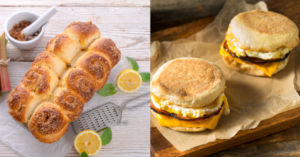What Is English Butter? (and Why You Should Care)
What To Know
- English butter is a premium butter produced in England from the cream of fresh cow’s milk.
- Salted butter has a slightly savory flavor, making it a popular choice for sandwiches, toast, and as a finishing touch to dishes.
- The high butterfat content of English butter imparts a rich and satisfying flavor to dishes, making it a culinary staple for gourmands and home cooks alike.
English butter, renowned for its velvety texture, rich flavor, and golden hue, has captivated culinary enthusiasts for centuries. But what sets this dairy delicacy apart from its counterparts? Delve into this comprehensive guide to discover the unique qualities, production methods, and culinary uses of English butter.
What is English Butter?
English butter is a premium butter produced in England from the cream of fresh cow’s milk. It is characterized by its high butterfat content (80% or more), resulting in an exceptionally rich and flavorful taste. The cows grazing in England’s lush pastures contribute to the butter’s distinctive aroma and nutritional value.
Production Methods
The production of English butter adheres to strict standards to ensure its exceptional quality.
1. Cream Separation
Fresh cow’s milk is first separated into cream and skim milk. The cream contains the butterfat, which is essential for butter production.
2. Culturing
The cream is then cultured with lactic acid bacteria, which gives English butter its characteristic tangy flavor. This process also helps to extend its shelf life.
3. Churning
The cultured cream is churned until the butterfat separates from the buttermilk. The churning process can be done manually or mechanically.
4. Washing and Salting
The butter is washed with cold water to remove any remaining buttermilk. It can then be salted or unsalted, depending on the desired flavor profile.
Types of English Butter
1. Unsalted Butter
Unsalted butter is the purest form of English butter, offering a clean and versatile flavor. It is ideal for baking, cooking, and spreading on bread or crackers.
2. Salted Butter
Salted butter has a slightly savory flavor, making it a popular choice for sandwiches, toast, and as a finishing touch to dishes. The amount of salt added varies depending on the brand.
Culinary Uses
English butter’s rich flavor and texture make it a versatile ingredient in countless culinary creations.
1. Baking
English butter is essential for creating flaky pastries, tender cakes, and flavorful cookies. Its high butterfat content contributes to the desired texture and richness.
2. Cooking
English butter adds depth of flavor to sauces, soups, and sautéed dishes. It can also be used as a flavorful cooking oil for meats, fish, and vegetables.
3. Spreading
Spreadable English butter is a luxurious topping for bread, crackers, and toast. Its velvety texture and rich flavor make it a delightful accompaniment to any meal.
Benefits of English Butter
1. Rich in Nutrients
English butter is a good source of essential vitamins, including A, D, and E. It also contains conjugated linoleic acid (CLA), which has potential health benefits.
2. Enhances Flavor
The high butterfat content of English butter imparts a rich and satisfying flavor to dishes, making it a culinary staple for gourmands and home cooks alike.
3. Versatile Ingredient
English butter’s versatility makes it a valuable addition to any kitchen. It can be used in various applications, from baking to cooking and spreading.
The Bottom Line: The Epitome of Butter
English butter is a culinary treasure that embodies the essence of quality and flavor. Its unique production methods, rich texture, and versatile uses make it a beloved ingredient among discerning palates. Whether you are a seasoned chef or a home cook, incorporating English butter into your culinary creations will elevate your dishes to new heights of deliciousness.
Answers to Your Questions
1. What is the difference between English butter and American butter?
English butter typically has a higher butterfat content (80% or more) compared to American butter (80-82%). This results in a richer flavor and a more velvety texture.
2. Why is English butter so expensive?
The high production standards, limited availability, and labor-intensive process contribute to the higher cost of English butter.
3. How long does English butter last?
Unsalted English butter can last for up to 3 months in the refrigerator, while salted butter can last for up to 6 months.
